Foliage Biophysical Trait Prediction from Laboratory Spectra in Norway Spruce Is More Affected by Needle Age Than by Site Soil Conditions
Abstract
1. Introduction
2. Materials and Methods
2.1. Description of Study Sites
2.2. Soil Sampling and Analyses
2.3. Needle Sampling and Analyses
2.3.1. Needle Spectra Acquisition and Preprocessing
2.3.2. Assessment of Needle Biophysical Traits
2.4. Statistical Analyses and PLSR Modeling
3. Results
3.1. Needle Biophysical Traits—Age Effects
3.2. Variation among the GEOMON Catchments in Needle Traits and Soil Properties
3.3. Needle Optical Properties
3.4. Needle Optical Properties—Age and Site Effects
3.5. Needle Traits PLSR Modeling—NACs Effect
4. Discussion
4.1. Needle Biophysical Traits—Age Effects
4.2. Needle Traits and Soil Properties—Site Effects
4.3. Variation in Needle Optical Properties—Age and Site Effects
4.4. Needle Traits PLSR Modeling—NACs Effect
5. Conclusions
Supplementary Materials
Author Contributions
Funding
Data Availability Statement
Acknowledgments
Conflicts of Interest
References
- McGloin, R.; Šigut, L.; Fischer, M.; Foltýnová, L.; Chawla, S.; Trnka, M.; Pavelka, M.; Marek, M.V. Available Energy Partitioning During Drought at Two Norway Spruce Forests and a European Beech Forest in Central Europe. J. Geophys. Res. Atmos. 2019, 124, 3726–3742. [Google Scholar] [CrossRef]
- Altman, J.; Fibich, P.; Santruckova, H.; Dolezal, J.; Stepanek, P.; Kopacek, J.; Hunova, I.; Oulehle, F.; Tumajer, J.; Cienciala, E. Environmental factors exert strong control over the climate-growth relationships of Picea Abies in Central Europe. Sci. Total Environ. 2017, 609, 506–516. [Google Scholar] [CrossRef]
- Sitková, Z.; Sitko, R.; Vejpustková, M.; Pajtík, J.; Šrámek, V. Intra- and Interannual Variability in Diameter Increment of Fagus Sylvatica L. and Picea Abies L. Karst. in Relation to Weather Variables. Cent. Eur. For. J. 2018, 64, 223–237. [Google Scholar] [CrossRef]
- Tumajer, J.; Altman, J.; Štěpánek, P.; Treml, V.; Doležal, J.; Cienciala, E. Increasing moisture limitation of Norway spruce in Central Europe revealed by forward modelling of tree growth in tree-ring network. Agric. For. Meteorol. 2017, 247, 56–64. [Google Scholar] [CrossRef]
- Mezei, P.; Jakuš, R.; Pennerstorfer, J.; Havašová, M.; Škvarenina, J.; Ferenčík, J.; Slivinský, J.; Bičárová, S.; Bilčík, D.; Blaženec, M.; et al. Storms, temperature maxima and the Eurasian spruce bark beetle Ips typographus—An infernal trio in Norway spruce forests of the Central European High Tatra Mountains. Agric. For. Meteorol. 2017, 242, 85–95. [Google Scholar] [CrossRef]
- Oulehle, F.; Wright, R.F.; Svoboda, M.; Bače, R.; Matějka, K.; Kaňa, J.; Hruška, J.; Couture, R.-M.; Kopáček, J. Effects of Bark Beetle Disturbance on Soil Nutrient Retention and Lake Chemistry in Glacial Catchment. Ecosystems 2019, 22, 725–741. [Google Scholar] [CrossRef]
- Potterf, M.; Nikolov, C.; Kočická, E.; Ferenčík, J.; Mezei, P.; Jakuš, R. Landscape-level spread of beetle infestations from windthrown- and beetle-killed trees in the non-intervention zone of the Tatra National Park, Slovakia (Central Europe). For. Ecol. Manag. 2019, 432, 489–500. [Google Scholar] [CrossRef]
- Holuša, J.; Lubojacký, J.; Curn, V.; Tonka, T.; Lukášová, K.; Horák, J. Combined effects of drought stress and Armillaria infection on tree mortality in Norway spruce plantations. For. Ecol. Manag. 2018, 427, 434–445. [Google Scholar] [CrossRef]
- Knížek, M. (Ed.) Škodliví Činitelé v Lesích Česka 2018/2019. Historie a Současnost Kůrovcových Kalamitve Střední Evropě; Zpravodaj Ochrany Lesa; Forestry and Game Management Research Institute: Jíloviště, Czechia, 2019; ISBN 978-80-7417-186-4. (In Czech) [Google Scholar]
- Campbell, P.K.E.; Rock, B.N.; Martín, M.E.; Neefus, C.D.; Irons, J.R.; Middleton, E.M.; Albrechtová, J. Detection of initial damage in Norway spruce canopies using hyperspectral airborne data. Int. J. Sens. 2004, 25, 5557–5583. [Google Scholar] [CrossRef]
- Kupková, L.; Potůčková, M.; Lhotáková, Z.; Albrechtová, J. Forest cover and disturbance changes, and their driving forces: A case study in the Ore Mountains, Czechia, heavily affected by anthropogenic acidic pollution in the second half of the 20th century. Environ. Res. Lett. 2018, 13, 095008. [Google Scholar] [CrossRef]
- Putalová, T.; Vacek, Z.; Vacek, S.; Štefančík, I.; Bulušek, D.; Král, J. Tree-Ring Widths as an Indicator of Air Pollution Stress and Climate Conditions in Different Norway Spruce Forest Stands in the Krkonoše Mts. Cent. Eur. For. J. 2018, 64, 21–33. [Google Scholar] [CrossRef]
- Fottová, D. Regional evaluation of mass element fluxes: Geomon network of small catchments. Environ. Monit. Assess. 1995, 34, 215–221. [Google Scholar] [CrossRef] [PubMed]
- Fottová, D.; Skorepova, I. Changes in Mass Element Fluxes and their Importance for Critical Loads: Geomon Network, Czech Republic. Water Air Soil Pollut. 1998, 105, 365–376. [Google Scholar] [CrossRef]
- Hruška, J.; Moldan, F.; Krám, P. Recovery from acidification in central Europe—observed and predicted changes of soil and streamwater chemistry in the Lysina catchment, Czech Republic. Environ. Pollut. 2002, 120, 261–274. [Google Scholar] [CrossRef]
- Oulehle, F.; Chuman, T.; Hruška, J.; Krám, P.; McDowell, W.H.; Myška, O.; Navrátil, T.; Tesař, M. Recovery from acidification alters concentrations and fluxes of solutes from Czech catchments. Biogeochemistry 2017, 132, 251–272. [Google Scholar] [CrossRef]
- Hruška, J.; Cudlín, P.; Krám, P. Relationships between Norway Spruce Status and Soil Water Base Cations/Aluminium in the Czech Republic. Water Air Soil Pollut. 2001, 130, 983–988. [Google Scholar] [CrossRef]
- Růžek, M.; Myška, O.; Kučera, J.; Oulehle, F. Input-Output Budgets of Nutrients in Adjacent Norway Spruce and European Beech Monocultures Recovering from Acidification. Forests 2019, 10, 68. [Google Scholar] [CrossRef]
- Hruška, J.; Krám, P.; McDowell, W.H.; Oulehle, F. Increased Dissolved Organic Carbon (DOC) in Central European Streamsis Driven by Reductions in Ionic Strength Rather than Climate Change or Decreasing Acidity. Environ. Sci. Technol. 2009, 43, 4320–4326. [Google Scholar] [CrossRef]
- Krám, P.; Hruška, J.; Shanley, J.B. Streamwater chemistry in three contrasting monolithologic Czech catchments. Appl. Geochem. 2012, 27, 1854–1863. [Google Scholar] [CrossRef]
- Novotný, J.; Navrátilová, B.; Janoutová, R.; Oulehle, F.; Homolová, L. Influence of Site-Specific Conditions on Estimation of Forest above Ground Biomass from Airborne Laser Scanning. Forests 2020, 11, 268. [Google Scholar] [CrossRef]
- Švik, M.; Oulehle, F.; Krám, P.; Janoutová, R.; Tajovská, K.; Homolová, L. Landsat-Based Indices Reveal Consistent Recovery of Forested Stream Catchments from Acid Deposition. Remote Sens. 2020, 12, 1944. [Google Scholar] [CrossRef]
- Huang, C.; Anderegg, W.R.L.; Asner, G.P. Remote sensing of forest die-off in the Anthropocene: From plant ecophysiology to canopy structure. Remote Sens. Environ. 2019, 231, 111233. [Google Scholar] [CrossRef]
- Kopackova, V.; Misurec, J.; Lhotáková, Z.; Oulehle, F.; Albrechtová, J. Using multi-date high spectral resolution data to assess the physiological status of macroscopically undamaged foliage on a regional scale. Int. J. Appl. Earth Obs. Geoinf. 2014, 27, 169–186. [Google Scholar] [CrossRef]
- Mišurec, J.; Kopačková, V.; Lhotáková, Z.; Campbell, P.; Albrechtová, J. Detection of Spatio-Temporal Changes of Norway Spruce Forest Stands in Ore Mountains Using Landsat Time Series and Airborne Hyperspectral Imagery. Remote Sens. 2016, 8, 92. [Google Scholar] [CrossRef]
- Mišurec, J.; Kopačková, V.; Lhotáková, Z.; Hanuš, J.; Weyermann, J.; Entcheva-Campbell, P.; Albrechtová, J. Utilization of Hyperspectral Image Optical Indices to Assess the Norway Spruce Forest Health Status. J. Appl. Remote Sens. 2012, 6, 063545. [Google Scholar] [CrossRef]
- Rock, B.N.; Hoshizaki, T.; Miller, J.R. Comparison of in situ and airborne spectral measurements of the blue shift associated with forest decline. Remote Sens. Environ. 1988, 24, 109–127. [Google Scholar] [CrossRef]
- Gates, D.M.; Keegan, H.J.; Schleter, J.C.; Weidner, V.R. Spectral Properties of Plants. Appl. Opt. 1965, 4, 11–20. [Google Scholar] [CrossRef]
- Kokaly, R.F.; Asner, G.P.; Ollinger, S.V.; Martin, M.E.; Wessman, C.A. Characterizing canopy biochemistry from imaging spectroscopy and its application to ecosystem studies. Remote Sens. Environ. 2009, 113, S78–S91. [Google Scholar] [CrossRef]
- Ustin, S.L.; Gitelson, A.A.; Jacquemoud, S.; Schaepman, M.; Asner, G.P.; Gamon, J.A.; Zarco-Tejada, P. Retrieval of foliar information about plant pigment systems from high resolution spectroscopy. Remote Sens. Environ. 2009, 113, S67–S77. [Google Scholar] [CrossRef]
- Madritch, M.; Cavender-Bares, J.; Hobbie, S.E.; Townsend, P.A. Linking Foliar Traits to Belowground Processes. In Remote Sensing of Plant Biodiversity; Springer International Publishing: Cham, Switzerland, 2020; pp. 193–217. ISBN 978-3-030-33157-3. [Google Scholar]
- Madritch, M.D.; Kingdon, C.C.; Singh, A.; Mock, K.E.; Lindroth, R.L.; Townsend, P.A. Imaging spectroscopy links aspen genotype with below-ground processes at landscape scales. Philos. Trans. R. Soc. B Biol. Sci. 2014, 369, 20130194. [Google Scholar] [CrossRef]
- Mzinyane, T.; Van Aardt, J.; Gebreslasie, M.T. Soil Carbon Estimation from Eucalyptus Grandis Using Canopy Spectra. South Afr. J. Geomat. 2015, 4, 548. [Google Scholar] [CrossRef][Green Version]
- Albrechtová, J.; Seidl, Z.; Aitkenhead-Peterson, J.; Lhotáková, Z.; Rock, B.N.; Alexander, J.E.; Malenovský, Z.; McDowell, W.H. Spectral analysis of coniferous foliage and possible links to soil chemistry: Are spectral chlorophyll indices related to forest floor dissolved organic C and N? Sci. Total Environ. 2008, 404, 424–432. [Google Scholar] [CrossRef] [PubMed]
- Rautiainen, M.; Lukeš, P.; Homolová, L.; Hovi, A.; Pisek, J.; Mõttus, M. Spectral properties of coniferous forests: A review of in situ and laboratory measurements. Remote Sens. 2018, 10, 207. [Google Scholar] [CrossRef]
- Homolová, L.; Lukeš, P.; Malenovský, Z.; Lhotáková, Z.; Kaplan, V.; Hanuš, J. Measurement methods and variability assessment of the Norway spruce total leaf area: Implications for remote sensing. Trees 2013, 27, 111–121. [Google Scholar] [CrossRef]
- O’Neill, A.L.; Kupiec, J.A.; Curran, P.J. Biochemical and reflectance variation throughout a Sitka spruce canopy. Remote Sens. Environ. 2002, 80, 134–142. [Google Scholar] [CrossRef]
- Nybakken, L.; Lie, M.H.; Julkunen-Tiitto, R.; Asplund, J.; Ohlson, M. Fertilization Changes Chemical Defense in Needles of Mature Norway Spruce (Picea Abies). Front. Plant Sci. 2018, 9, 9. [Google Scholar] [CrossRef]
- Rummukainen, A.; Julkunen-Tiitto, R.; Ryyppö, A.; Kaunisto, S.; Kilpeläinen, J.; Lehto, T. Long-term effects of boron and copper on phenolics and monoterpenes in Scots pine (Pinus sylvestris L.) needles. Plant Soil 2013, 373, 485–499. [Google Scholar] [CrossRef]
- Robakowski, P.; Bielinis, E. Needle age dependence of photosynthesis along a light gradient within an Abies alba crown. Acta Physiol. Plant. 2017, 39. [Google Scholar] [CrossRef]
- Achat, D.L.; Pousse, N.; Nicolas, M.; Augusto, L. Nutrient remobilization in tree foliage as affected by soil nutrients and leaf life span. Ecol. Monogr. 2018, 88, 408–428. [Google Scholar] [CrossRef]
- Aphalo, P.; Schoettle, A.; Lehto, T. Leaf life span and the mobility of “non-mobile” mineral nutrients—the case of boron in conifers. Silva Fenn. 2002, 36. [Google Scholar] [CrossRef]
- Szymura, T.H. Concentration of elements in silver fir (Abies alba Mill.) needles as a function of needles’ age. Trees 2009, 23, 211–217. [Google Scholar] [CrossRef]
- Kubínová, Z.; Janáček, J.; Lhotáková, Z.; Šprtová, M.; Kubínová, L.; Albrechtová, J. Norway spruce needle size and cross section shape variability induced by irradiance on a macro- and microscale and CO2 concentration. Trees 2018, 32, 231–244. [Google Scholar] [CrossRef]
- Lukeš, P.; Stenberg, P.; Rautiainen, M.; Mõttus, M.; Vanhatalo, K.M. Optical properties of leaves and needles for boreal tree species in Europe. Remote Sens. Lett. 2013, 4, 667–676. [Google Scholar] [CrossRef]
- Deepak, M.; Keski-Saari, S.; Fauch, L.; Granlund, L.; Oksanen, E.; Keinänen, M. Leaf Canopy Layers Affect Spectral Reflectance in Silver Birch. Remote Sens. 2019, 11, 2884. [Google Scholar] [CrossRef]
- Lhotáková, Z.; Albrechtová, J.; Malenovský, Z.; Rock, B.N.; Polák, T.; Cudlín, P. Does the azimuth orientation of Norway spruce (Picea Abies/L./Karst.) branches within sunlit crown part influence the heterogeneity of biochemical, structural and spectral characteristics of needles? Environ. Exp. Bot. 2007, 59, 283–292. [Google Scholar] [CrossRef]
- Atherton, J.; Olascoaga, B.; Alonso, L.; Porcar-Castell, A. Spatial Variation of Leaf Optical Properties in a Boreal Forest Is Influenced by Species and Light Environment. Front. Plant Sci. 2017, 8, 309. [Google Scholar] [CrossRef]
- de Tomás Marín, S.; Novák, M.; Klančnik, K.; Gaberščik, A. Spectral Signatures of Conifer Needles Mainly Depend on Their Physical Traits. Pol. J. Ecol. 2016, 64, 1–13. [Google Scholar] [CrossRef]
- Hernández-Clemente, R.; Navarro-Cerrillo, R.M.; Suárez, L.; Morales, F.; Zarco-Tejada, P.J. Assessing structural effects on PRI for stress detection in conifer forests. Remote Sens. Environ. 2011, 115, 2360–2375. [Google Scholar] [CrossRef]
- Kováč, D.; Malenovský, Z.; Urban, O.; Spunda, V.; Kalina, J.; Ač, A.; Kaplan, V.; Hanuš, J. Response of green reflectance continuum removal index to the xanthophyll de-epoxidation cycle in Norway spruce needles. J. Exp. Bot. 2013, 64, 1817–1827. [Google Scholar] [CrossRef]
- Bernier, P.Y.; Raulier, F.; Stenberg, P.; Ung, C.-H. Importance of needle age and shoot structure on canopy net photosynthesis of balsam fir (Abies balsamea): A spatially inexplicit modeling analysis. Tree Physiol. 2001, 21, 815–830. [Google Scholar] [CrossRef]
- Jensen, A.M.; Warren, J.M.; Hanson, P.J.; Childs, J.; Wullschleger, S.D. Needle age and season influence photosynthetic temperature response and total annual carbon uptake in mature Picea mariana trees. Ann. Bot. 2015, 116, 821–832. [Google Scholar] [CrossRef] [PubMed]
- Warren, C.R. Why does photosynthesis decrease with needle age in Pinus pinaster? Trees 2006, 20, 157–164. [Google Scholar] [CrossRef]
- Chuman, T.; Oulehle, F.; Zajícová, K.; Hruška, J. The Legacy of Acidic Deposition Controls Soil Organic Carbon Pools in Temperate Forests across the Czech Republic. Eur. J. Soil Sci. 2020, 1–22. [Google Scholar] [CrossRef]
- Malenovský, Z.; Albrechtová, J.; Lhotáková, Z.; Zurita-Milla, R.; Clevers, J.G.P.W.; Schaepman, M.E.; Cudlín, P. Applicability of the PROSPECT model for Norway spruce needles. Int. J. Remote Sens. 2006, 27, 5315–5340. [Google Scholar] [CrossRef]
- Yanez-Rausell, L.; Malenovsky, Z.; Clevers, J.G.P.W.; Schaepman, M.E. Minimizing Measurement Uncertainties of Coniferous Needle-Leaf Optical Properties. Part II: Experimental Setup and Error Analysis. IEEE J. Sel. Top. Appl. Earth Obs. Remote Sens. 2014, 7, 406–420. [Google Scholar] [CrossRef]
- Di Vittorio, A.V. Enhancing a leaf radiative transfer model to estimate concentrations and in vivo specific absorption coefficients of total carotenoids and chlorophylls a and b from single-needle reflectance and transmittance. Remote Sens. Environ. 2009, 113, 1948–1966. [Google Scholar] [CrossRef]
- Mesarch, M.A.; Walter-Shea, E.A.; Asner, G.P.; Middleton, E.M.; Chan, S.S. A Revised Measurement Methodology for Conifer Needles Spectral Optical Properties: Evaluating the Influence of Gaps between Elements. Remote Sens. Environ. 1999, 68, 177–192. [Google Scholar]
- Olascoaga, B.; Mac Arthur, A.; Atherton, J.; Porcar-Castell, A. A comparison of methods to estimate photosynthetic light absorption in leaves with contrasting morphology. Tree Physiol. 2016, 36, 368–379. [Google Scholar] [CrossRef]
- Porra, R.; Thompson, W.; Kriedemann, P. Determination of Accurate Extinction Coefficients and Simultaneous-Equations for Assaying Chlorophyll-a and Chlorophyll-B Extracted with 4 Different Solvents—Verification of the Concentration. Biochim. Biophys. Acta 1989, 975, 384–394. [Google Scholar] [CrossRef]
- Wellburn, A.R. The Spectral Determination of Chlorophylls a and b, as well as Total Carotenoids, Using Various Solvents with Spectrophotometers of Different Resolution. J. Plant Physiol. 1994, 144, 307–313. [Google Scholar] [CrossRef]
- Singleton, V.L.; Rossi, J.A. Colorimetry of Total Phenolics with Phosphomolybdic-Phosphotungstic Acid Reagents. Am. J. Enol. Vitic. 1965, 16, 144–158. [Google Scholar]
- Lange, B.; Lapierre, C.; Sandermann, H. Elicitor-Induced Spruce Stress Lignin—Structural Similarity to Early Developmental Lignins. Plant Physiol. 1995, 108, 1277–1287. [Google Scholar] [CrossRef] [PubMed]
- Loader, N.J.; Robertson, I.; Barker, A.C.; Switsur, V.R.; Waterhouse, J.S. An improved technique for the batch processing of small wholewood samples to α-cellulose. Chem. Geol. 1997, 136, 313–317. [Google Scholar] [CrossRef]
- Pinheiro, J.; Bates, D.; DebRoy, S.; Sarkar, D. Nlme: Linear and Nonlinear Mixed Effects, 2020.
- Esbensen, K.H.; Swarbrick, B.; Westad, F.; Whitcomb, P.; Anderson, M. Multivariate Data Analysis: An Introduction to Multivariate Analysis, Process Analytical Technology and Quality by Design, 6th ed.; CAMO Software AS: Oslo Magnolia, TX, USA, 2018; ISBN 978-82-691104-0-1. [Google Scholar]
- Zhao, N.; Wu, Z.; Zhang, Q.; Shi, X.; Ma, Q.; Qiao, Y. Optimization of Parameter Selection for Partial Least Squares Model Development. Sci. Rep. 2015, 5, 11647. [Google Scholar] [CrossRef] [PubMed]
- Kopačková, V.; Ben-Dor, E.; Carmon, N.; Notesco, G. Modelling Diverse Soil Attributes with Visible to Longwave Infrared Spectroscopy Using PLSR Employed by an Automatic Modelling Engine. Remote Sens. 2017, 9, 134. [Google Scholar] [CrossRef]
- Heise, H.M.; Damm, U.; Lampen, P.; Davies, A.N.; McIntyre, P.S. Spectral Variable Selection for Partial Least Squares Calibration Applied to Authentication and Quantification of Extra Virgin Olive Oils Using Fourier Transform Raman Spectroscopy. Appl. Spectrosc. 2005, 59, 1286–1294. [Google Scholar] [CrossRef]
- Eisele, A.; Lau, I.; Hewson, R.; Carter, D.; Wheaton, B.; Ong, C.; Cudahy, T.; Chabrillat, S.; Kaufmann, H. Applicability of the Thermal Infrared Spectral Region for the Prediction of Soil Properties Across Semi-Arid Agricultural Landscapes. Remote Sens. 2012, 4, 3265–3286. [Google Scholar] [CrossRef]
- Asner, G.P.; Martin, R.E.; Anderson, C.B.; Knapp, D.E. Quantifying forest canopy traits: Imaging spectroscopy versus field survey. Remote Sens. Environ. 2015, 158, 15–27. [Google Scholar] [CrossRef]
- Kokaly, R.F.; Rockwell, B.W.; Haire, S.L.; King, T.V.V. Characterization of post-fire surface cover, soils, and burn severity at the Cerro Grande Fire, New Mexico, using hyperspectral and multispectral remote sensing. Remote Sens. Environ. 2007, 106, 305–325. [Google Scholar] [CrossRef]
- Serrano, L.; Peñuelas, J.; Ustin, S.L. Remote sensing of nitrogen and lignin in Mediterranean vegetation from AVIRIS data: Decomposing Biochemical from Structural Signals. Remote Sens. Environ. 2002, 81, 355–364. [Google Scholar] [CrossRef]
- Kirchgeßner, H.-D.; Reichert, K.; Hauff, K.; Steinbrecher, R.; Schnitzler, J.-P.; Pfündel, E.E. Light and temperature, but not UV radiation, affect chlorophylls and carotenoids in Norway spruce needles (Picea Abies (L.) Karst.). Plant Cell Environ. 2003, 26, 1169–1179. [Google Scholar] [CrossRef]
- Soukupová, J.; Rock, B.N.; Albrechtová, J. Comparative study of two spruce species in a polluted mountainous region. New Phytol. 2001, 150, 133–145. [Google Scholar] [CrossRef]
- Proe, M.F.; Midwood, A.J.; Craig, J. Use of stable isotopes to quantify nitrogen, potassium and magnesium dynamics in young Scots pine (Pinus sylvestris). New Phytol. 2000, 146, 461–469. [Google Scholar] [CrossRef]
- Weatherall, A.; Proe, M.F.; Craig, J.; Cameron, A.D.; Midwood, A.J. Internal cycling of nitrogen, potassium and magnesium in young Sitka spruce. Tree Physiol. 2006, 26, 673–680. [Google Scholar] [CrossRef]
- Yuan, Z.; Shi, X.; Jiao, F.; Han, F. N and P resorption as functions of the needle age class in two conifer trees. J. Plant Ecol. 2018, 11, 780–788. [Google Scholar] [CrossRef]
- Lhotáková, Z.; Urban, O.; Dubánková, M.; Cvikrová, M.; Tomášková, I.; Kubinova, L.; Zvára, K.; Marek, M.V.; Albrechtová, J. The impact of long-term CO2 enrichment on sun and shade needles of Norway spruce (Picea Abies): Photosynthetic performance, needle anatomy and phenolics accumulation. Plant Sci. 2012, 188–189, 60–70. [Google Scholar] [CrossRef]
- Wild, A.; Schmitt, V. Diagnosis of Damage to Norway Spruce (Picea Abies) through Biochemical Criteria. Physiol. Plant. 1995, 93, 375–382. [Google Scholar] [CrossRef]
- Artemkina, N.A.; Orlova, M.A.; Lukina, N.V. Spatial Variation in the Concentration of Phenolic Compounds and Nutritional Elements in the Needles of Spruce in Northern Taiga Forests. Contemp. Probl. Ecol. 2019, 12, 769–779. [Google Scholar] [CrossRef]
- Aitkenhead-Peterson, J.A.; Alexander, J.E.; Albrechtová, J.; Krám, P.; Rock, B.N.; Cudlín, P.; Hruška, J.; Lhotáková, Z.; Hunt, R.; Oulehle, F.; et al. Linking Foliar Chemistry to Forest Floor Solid and Solution Phase Organic C and N in Picea abies [L.] Karst Stands in Northern Bohemia. Plant Soil 2006, 283, 187–201. [Google Scholar] [CrossRef]
- Jolly, W.M.; Hadlow, A.M.; Huguet, K. De-coupling seasonal changes in water content and dry matter to predict live conifer foliar moisture content. Int. J. Wildland Fire 2014, 23, 480–489. [Google Scholar] [CrossRef]
- Krám, P.; Oulehle, F.; Štědrá, V.; Hruška, J.; Shanley, J.B. Geoecology of a Forest Watershed Underlain by Serpentine in Central Europe. Northeast. Nat. 2009, 16, 309–328. [Google Scholar] [CrossRef]
- Novak, M.; Holmden, C.; Farkaš, J.; Kram, P.; Hruska, J.; Curik, J.; Veselovsky, F.; Stepanova, M.; Kochergina, Y.V.; Erban, V.; et al. Calcium and strontium isotope dynamics in three polluted forest ecosystems of the Czech Republic, Central Europe. Chem. Geol. 2020, 536, 119472. [Google Scholar] [CrossRef]
- Petrash, D.A.; Buzek, F.; Novak, M.; Cejkova, B.; Kram, P.; Chuman, T.; Curik, J.; Veselovsky, F.; Stepanova, M.; Myska, O.; et al. Spatially resolved soil solution chemistry in a central European atmospherically polluted high-elevation catchment. SOIL 2019, 5, 205–221. [Google Scholar] [CrossRef]
- Hovi, A.; Raitio, P.; Rautiainen, M. A spectral analysis of 25 boreal tree species. Silva Fenn. 2017, 51. [Google Scholar] [CrossRef]
- Rock, B.N.; Williams, D.L.; Moss, D.M.; Lauten, G.N.; Kim, M. High-spectral resolution field and laboratory optical reflectance measurements of red spruce and eastern hemlock needles and branches. Remote Sens. Environ. 1994, 47, 176–189. [Google Scholar] [CrossRef]
- Dengel, S.; Grace, J.; Aakala, T.; Hari, P.; Newberry, S.L.; Mizunuma, T. Spectral characteristics of pine needles at the limit of tree growth in subarctic Finland. Plant Ecol. Divers. 2013, 6, 31–44. [Google Scholar] [CrossRef]
- Wu, Q.; Song, C.; Song, J.; Wang, J.; Chen, S.; Yu, B. Impacts of Leaf Age on Canopy Spectral Signature Variation in Evergreen Chinese Fir Forests. Remote Sens. 2018, 10, 262. [Google Scholar] [CrossRef]
- Lhotáková, Z.; Brodský, L.; Kupková, L.; Kopačková, V.; Potůčková, M.; Mišurec, J.; Klement, A.; Kovářová, M.; Albrechtová, J. Detection of Multiple Stresses in Scots Pine Growing at Post-Mining Sites Using Visible to near-Infrared Spectroscopy. Environ. Sci. Process. Impacts 2013, 15, 2004–2015. [Google Scholar] [CrossRef]
- Daughtry, C.S.T.; Biehl, L.L.; Ranson, K.J. A new technique to measure the spectral properties of conifer needles. Remote Sens. Environ. 1989, 27, 81–91. [Google Scholar] [CrossRef]
- Hovi, A.; Mõttus, M.; Juola, J.; Manoocheri, F.; Ikonen, E.; Rautiainen, M. Evaluating the performance of a double integrating sphere in measurement of reflectance, transmittance, and albedo of coniferous needles. Silva Fenn. 2020, 54. [Google Scholar] [CrossRef]
- Noda, H.M.; Motohka, T.; Murakami, K.; Muraoka, H.; Nasahara, K.N. Accurate measurement of optical properties of narrow leaves and conifer needles with a typical integrating sphere and spectroradiometer: Measuring Optical Properties of Narrow Leaves. Plant Cell Environ. 2013, 36, 1903–1909. [Google Scholar] [CrossRef] [PubMed]
- Verrelst, J.; Malenovský, Z.; Van Der Tol, C.; Camps-Valls, G.; Gastellu-Etchegorry, J.-P.; Lewis, P.; North, P.; Moreno, J. Quantifying Vegetation Biophysical Variables from Imaging Spectroscopy Data: A Review on Retrieval Methods. Surv. Geophys. 2019, 40, 589–629. [Google Scholar] [CrossRef]
- Ely, K.S.; Burnett, A.C.; Lieberman-Cribbin, W.; Serbin, S.P.; Rogers, A. Spectroscopy can predict key leaf traits associated with source–sink balance and carbon–nitrogen status. J. Exp. Bot. 2019, 70, 1789–1799. [Google Scholar] [CrossRef] [PubMed]
- Nakaji, T.; Oguma, H.; Nakamura, M.; Kachina, P.; Asanok, L.; Marod, D.; Aiba, M.; Kurokawa, H.; Kosugi, Y.; Kassim, A.R.; et al. Estimation of six leaf traits of East Asian forest tree species by leaf spectroscopy and partial least square regression. Remote Sens. Environ. 2019, 233, 111381. [Google Scholar] [CrossRef]
- Serbin, S.P.; Singh, A.; McNeil, B.E.; Kingdon, C.C.; Townsend, P.A. Spectroscopic determination of leaf morphological and biochemical traits for northern temperate and boreal tree species. Ecol. Appl. 2014, 24, 1651–1669. [Google Scholar] [CrossRef] [PubMed]
- Masaitis, G.; Mozgeris, G.; Augustaitis, A. Spectral reflectance properties of healthy and stressed coniferous trees. iForest 2013, 6, 30–36. [Google Scholar] [CrossRef]
- Croft, H.; Chen, J.M.; Zhang, Y. The applicability of empirical vegetation indices for determining leaf chlorophyll content over different leaf and canopy structures. Ecol. Complex. 2014, 17, 119–130. [Google Scholar] [CrossRef]
- Drolet, G.G.; Middleton, E.M.; Huemmrich, K.F.; Hall, F.G.; Amiro, B.D.; Barr, A.G.; Black, T.A.; McCaughey, J.H.; Margolis, H.A. Regional Mapping of Gross Light-Use Efficiency Using MODIS Spectral Indices. Remote Sens. Environ. 2008, 112, 3064–3078. [Google Scholar] [CrossRef]
- Petisco, C.; García-Criado, B.; Mediavilla, S.; De Aldana, B.R.V.; Zabalgogeazcoa, I.; García-Ciudad, A. Near-infrared reflectance spectroscopy as a fast and non-destructive tool to predict foliar organic constituents of several woody species. Anal. Bioanal. Chem. 2006, 386, 1823–1833. [Google Scholar] [CrossRef]
- Schlerf, M.; Atzberger, C.; Hill, J.; Buddenbaum, H.; Werner, W.; Schüler, G. Retrieval of chlorophyll and nitrogen in Norway spruce (Picea abies L. Karst.) using imaging spectroscopy. Int. J. Appl. Earth Obs. Geoinf. 2010, 12, 17–26. [Google Scholar] [CrossRef]
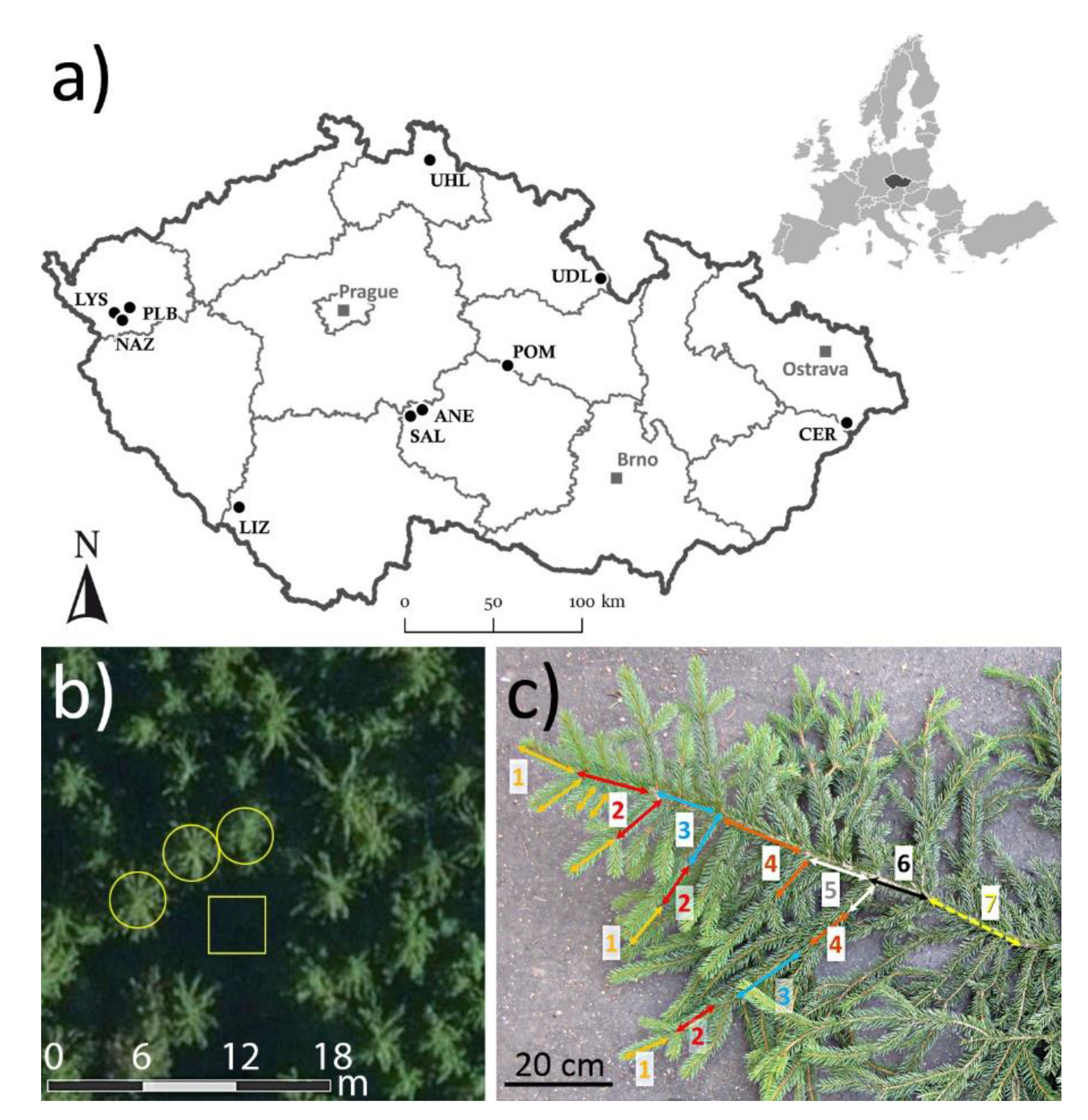
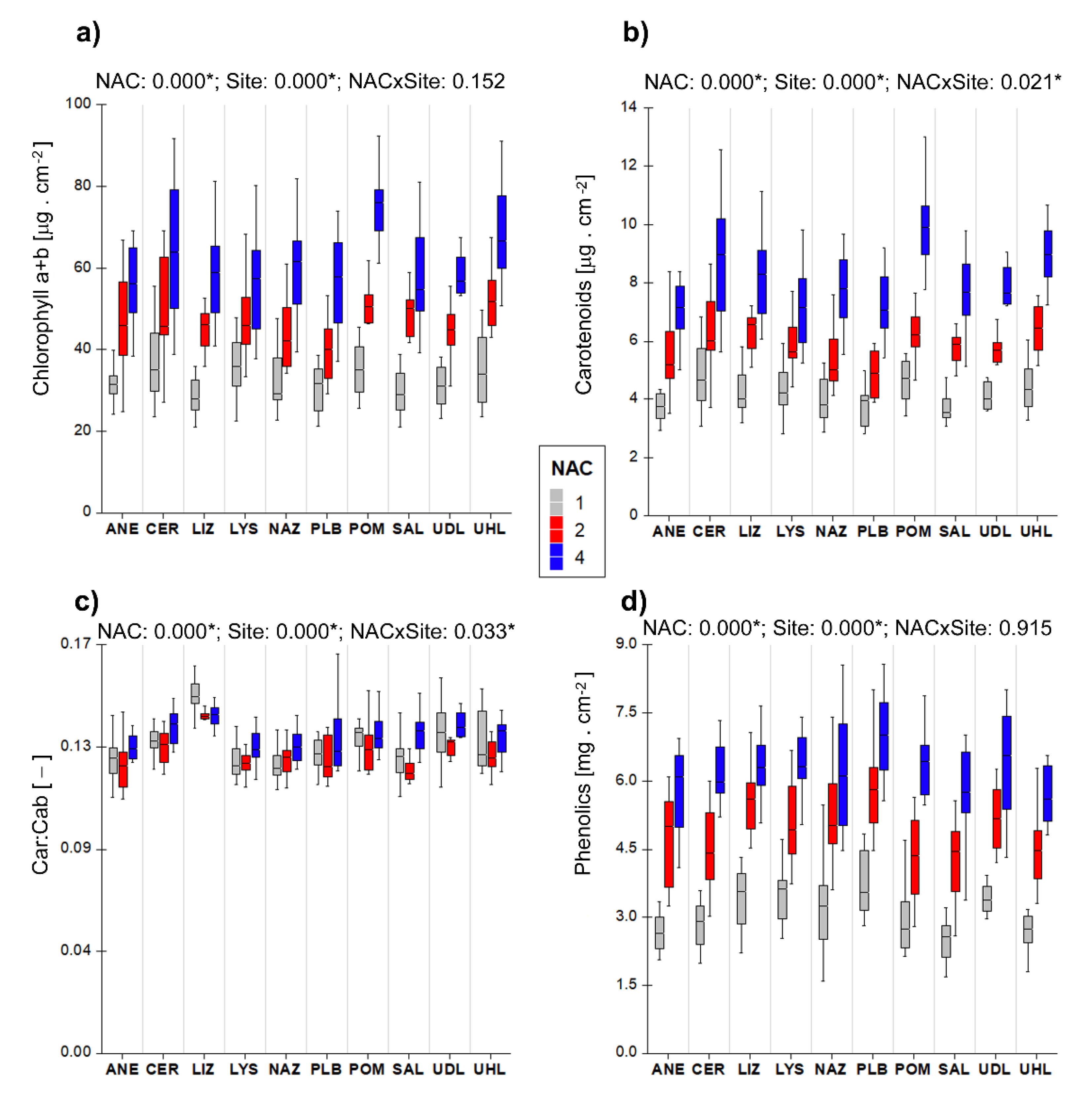
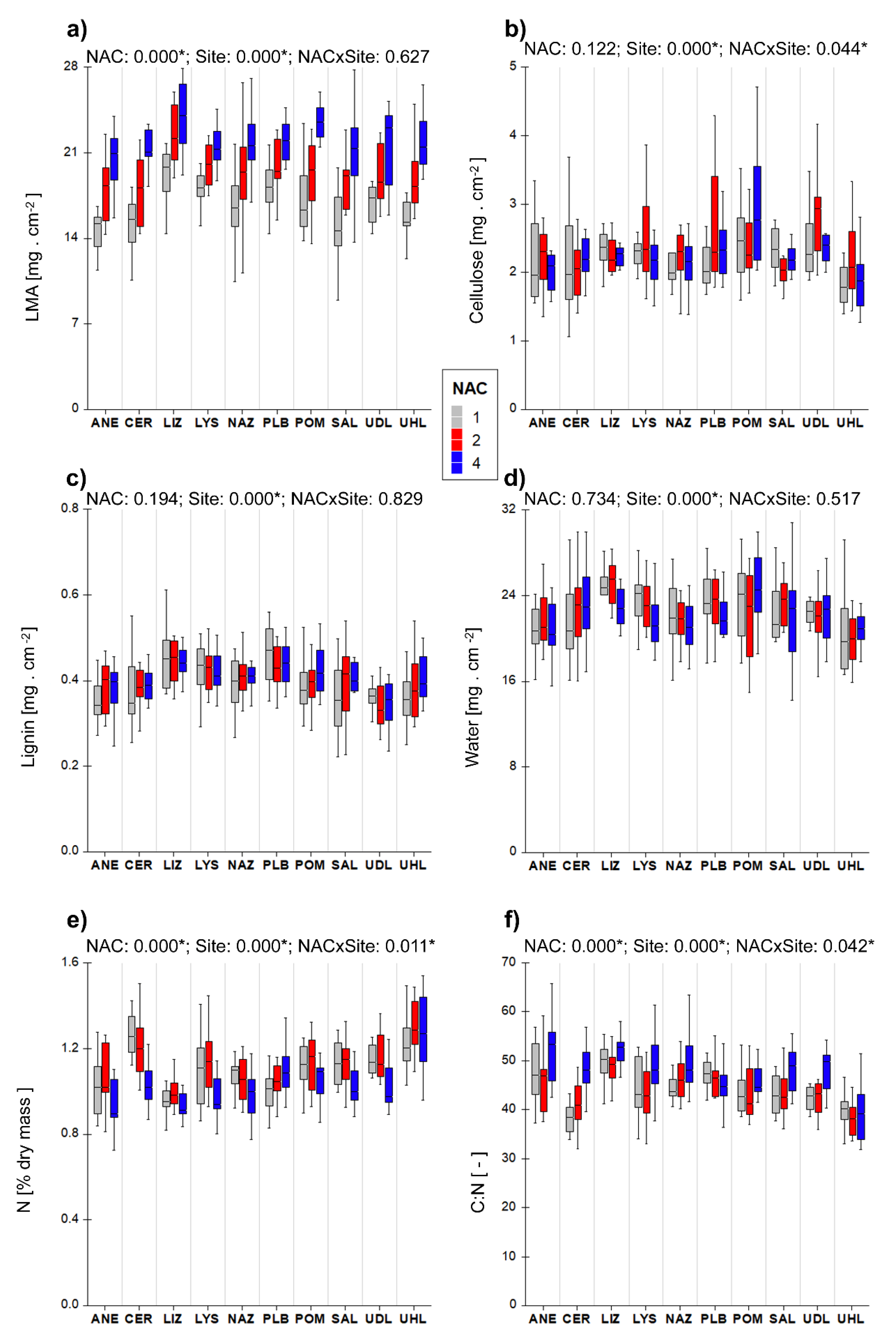
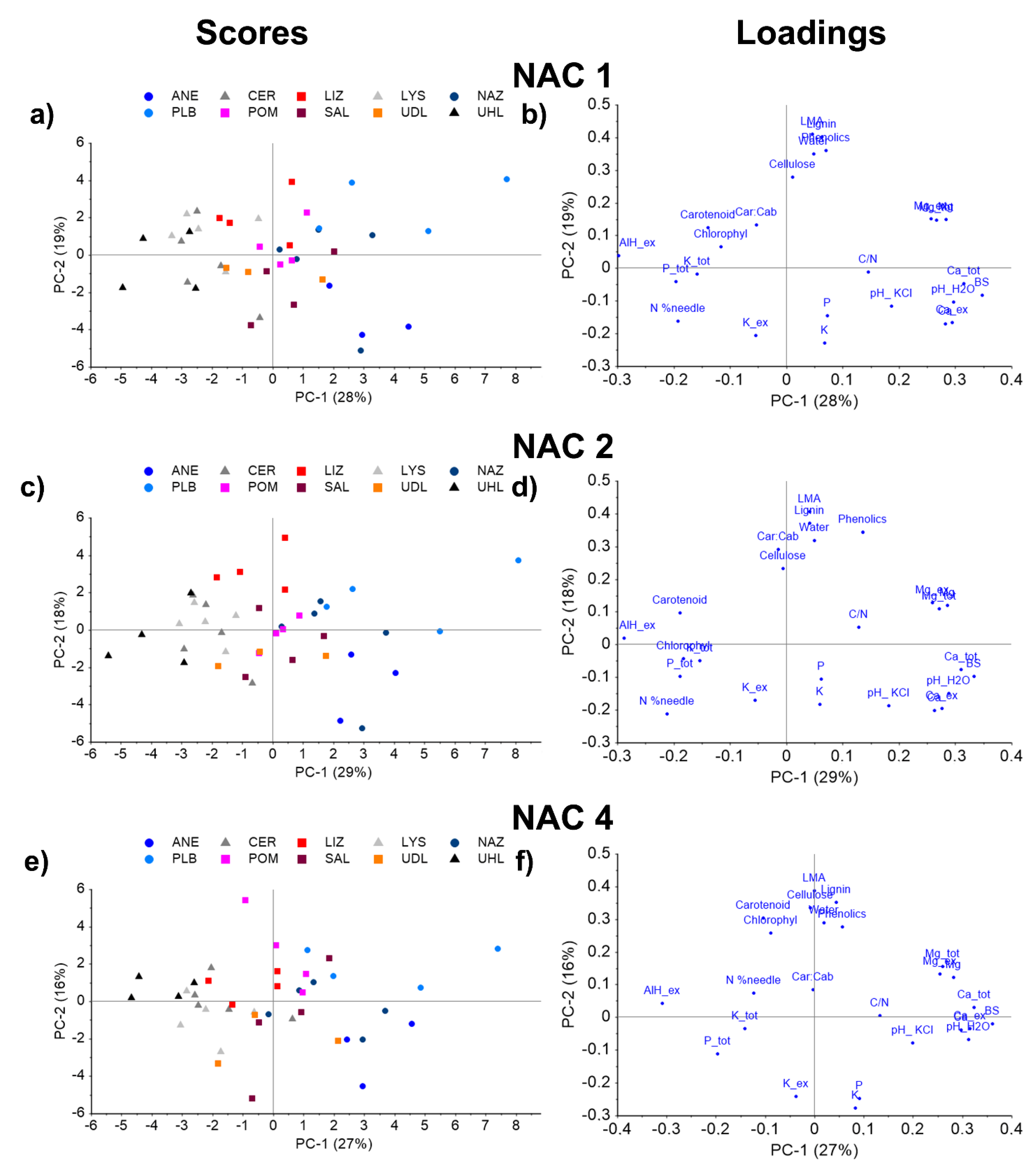
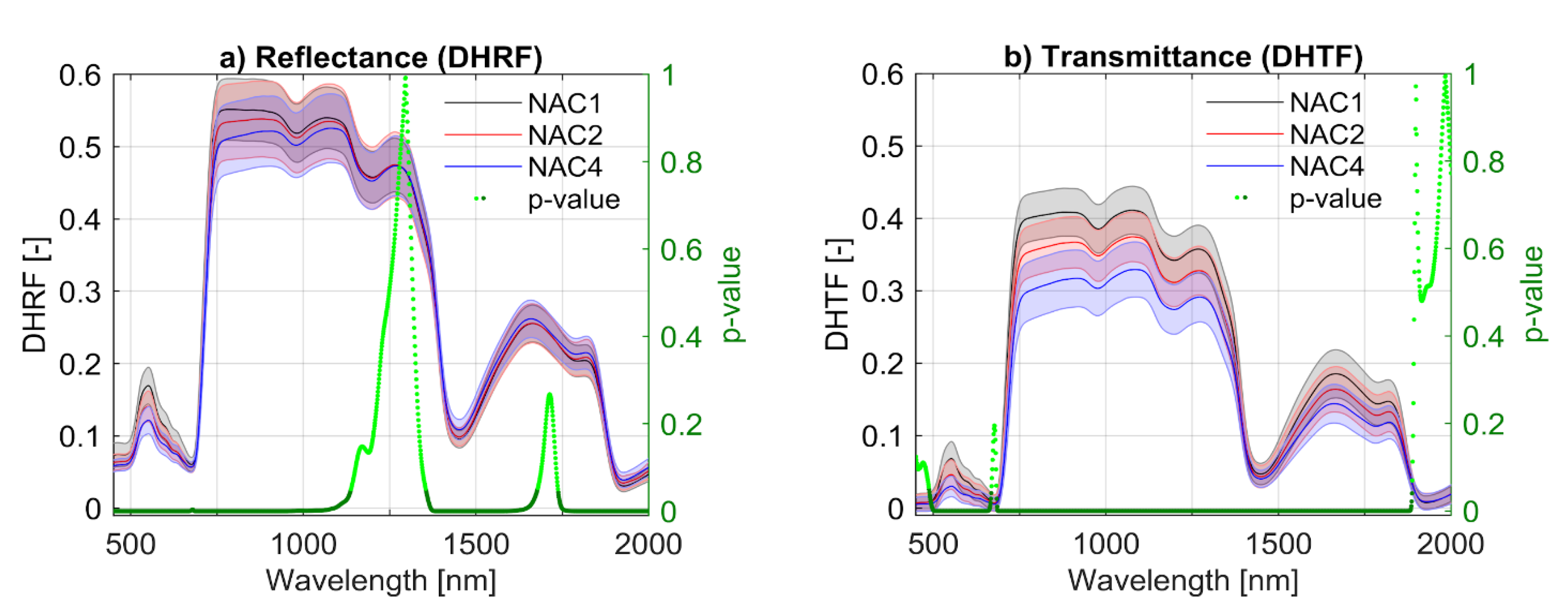
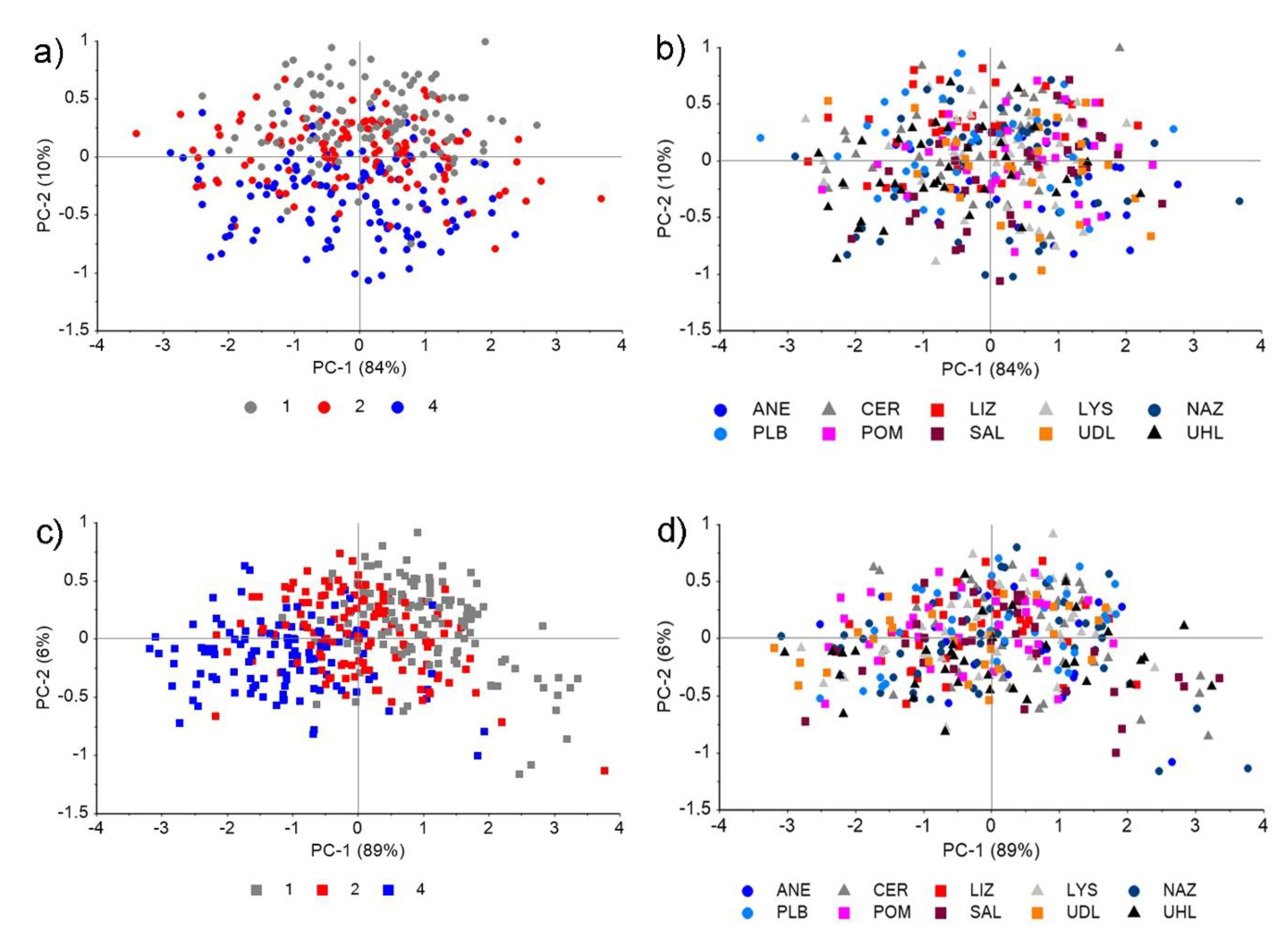


| Catchment Name | Code | Elevation (m a.s.l.) | Area (ha) | Bedrock | Soils | Forest Cover Conifer/Broadleaved (%) | Forest Age (yr) | Mean Temper-ature (°C) | Mean Precipitation (mm) | Forest Floor pH | Mineral Soil pH | Forest Floor C/N |
|---|---|---|---|---|---|---|---|---|---|---|---|---|
| Anenský potok | ANE | 486–546 | 26 | Paragneiss | Cambisols, Stagnic Cambisols | 85/2.6 | 40–60 | 8.3 | 673 | 4.00 | 4.67 | 22.1 |
| Červík | CER | 637–961 | 181 | Sandstone, Claystone | Cambisols, Stagnosols | 91/3 | 40–60 | 6.8 | 1212 | 3.40 | 4.13 | 21.2 |
| Liz | LIZ | 827–1070 | 94 | Paragneiss | Cambisosl, Dystric Cambisols | 84/8.5 | 60–100 | 6.1 | 892 | 3.50 | 4.38 | 24.3 |
| Lysina | LYS | 828–943 | 27 | Granite | Cambisols, Podzols | 93/0.5 | 40–60 | 6.3 | 1005 | 3.37 | 4.33 | 26.0 |
| Na zeleném | NAZ | 733–802 | 60 | Amphibolite | Cambisol | 79/4.6 | 60–100 | 6.8 | 857 | 3.86 | 5.07 | 26.0 |
| Pluhův bor | PLB | 690–796 | 22 | Serpentinite | Magnesic Cambisols | 69/0.6 | 60–100 | 6.8 | 861 | 3.85 | 5.82 | 30.8 |
| Polomka | POM | 554–650 | 66 | Paragneiss, Orthogneiss | Cambisols, Gleysols | 87/7 | 60–80 | 7.7 | 697 | 3.77 | 4.37 | 24.7 |
| Salačova Lhota | SAL | 560–745 | 200 | Paragneiss | Cambisols, Stagnic Cambisols | 88/4.6 | 60–80 | 7.6 | 675 | 3.46 | 4.30 | 29.4 |
| U dvou louček | UDL | 878–955 | 30 | Gneiss | Entic Podzols | 89/3 | 20–40 | 5.6 | 1502 | 3.75 | 4.43 | 20.5 |
| Uhlířská | UHL | 776–885 | 180 | Granite, Granodiorite | Entic Podzols, Distric Cambisols | 86/0.3 | 20–40 | 5.6 | 1250 | 3.50 | 4.33 | 21.5 |
| Data source: | DEM 5G—digital elevation model 2020 | DEM 5G | [16] | [16] | Classified from CASI airborne images | [16] | Oulehle 2020 pers. comm. Mean 1994–2019 | Krám 2019 pers. comm. |
| NAC 1 | NAC 2 | NAC 4 | Pooled NACs | |||||||||||||
|---|---|---|---|---|---|---|---|---|---|---|---|---|---|---|---|---|
| Needle Trait | R2 | RPD | RMSEP | RMSE% | R2 | RPD | RMSEP | RMSE% | R2 | RPD | RMSEP | RMSE% | R2 | RPD | RMSEP | RMSE% |
| Chlorophyll a+b | 0.44 | 1.34 | 5.31 | 15% | 0.39 | 1.26 | 7.25 | 16% | 0.43 | 1.33 | 10.44 | 16% | 0.71 | 1.86 | 8.38 | 11% |
| Carotenoids | 0.45 | 1.33 | 0.62 | 14% | 0.37 | 1.26 | 0.83 | 16% | 0.52 | 1.44 | 1.10 | 14% | 0.72 | 1.91 | 0.83 | 11% |
| Car:Cab ratio | 0.29 | 1.19 | 0.0100 | 17% | 0.26 | 1.33 | 0.0070 | 15% | 0.38 | 1.27 | 0.0070 | 13% | 0.31 | 1.17 | 0.0090 | 15% |
| Water | 0.61 | 1.61 | 2.02 | 13% | 0.56 | 1.51 | 2.18 | 13% | 0.53 | 1.47 | 2.00 | 12% | 0.60 | 1.58 | 2.01 | 11% |
| LMA | 0.73 | 1.95 | 0.0013 | 9% | 0.77 | 2.10 | 0.0014 | 8% | 0.54 | 1.47 | 0.0019 | 10% | 0.79 | 2.18 | 0.0016 | 9% |
| Phenolics | 0.45 | 1.34 | 0.55 | 14% | 0.53 | 1.49 | 0.71 | 12% | 0.31 | 1.21 | 0.81 | 15% | 0.73 | 1.93 | 0.82 | 11% |
| Lignin | 0.37 | 1.25 | 0.059 | 15% | 0.40 | 1.28 | 0.051 | 16% | 0.28 | 1.18 | 0.049 | 14% | 0.38 | 1.27 | 0.052 | 13% |
| Cellulose | 0.18 | 1.10 | 0.501 | 13% | 0.11 | 1.06 | 0.645 | 15% | 0.13 | 1.06 | 0.462 | 13% | 0.15 | 1.08 | 0.539 | 15% |
| N | 0.31 | 1.19 | 0.119 | 18% | 0.39 | 1.28 | 0.115 | 16% | 0.15 | 1.08 | 0.134 | 16% | 0.23 | 1.14 | 0.131 | 16% |
Publisher’s Note: MDPI stays neutral with regard to jurisdictional claims in published maps and institutional affiliations. |
© 2021 by the authors. Licensee MDPI, Basel, Switzerland. This article is an open access article distributed under the terms and conditions of the Creative Commons Attribution (CC BY) license (http://creativecommons.org/licenses/by/4.0/).
Share and Cite
Lhotáková, Z.; Kopačková-Strnadová, V.; Oulehle, F.; Homolová, L.; Neuwirthová, E.; Švik, M.; Janoutová, R.; Albrechtová, J. Foliage Biophysical Trait Prediction from Laboratory Spectra in Norway Spruce Is More Affected by Needle Age Than by Site Soil Conditions. Remote Sens. 2021, 13, 391. https://doi.org/10.3390/rs13030391
Lhotáková Z, Kopačková-Strnadová V, Oulehle F, Homolová L, Neuwirthová E, Švik M, Janoutová R, Albrechtová J. Foliage Biophysical Trait Prediction from Laboratory Spectra in Norway Spruce Is More Affected by Needle Age Than by Site Soil Conditions. Remote Sensing. 2021; 13(3):391. https://doi.org/10.3390/rs13030391
Chicago/Turabian StyleLhotáková, Zuzana, Veronika Kopačková-Strnadová, Filip Oulehle, Lucie Homolová, Eva Neuwirthová, Marian Švik, Růžena Janoutová, and Jana Albrechtová. 2021. "Foliage Biophysical Trait Prediction from Laboratory Spectra in Norway Spruce Is More Affected by Needle Age Than by Site Soil Conditions" Remote Sensing 13, no. 3: 391. https://doi.org/10.3390/rs13030391
APA StyleLhotáková, Z., Kopačková-Strnadová, V., Oulehle, F., Homolová, L., Neuwirthová, E., Švik, M., Janoutová, R., & Albrechtová, J. (2021). Foliage Biophysical Trait Prediction from Laboratory Spectra in Norway Spruce Is More Affected by Needle Age Than by Site Soil Conditions. Remote Sensing, 13(3), 391. https://doi.org/10.3390/rs13030391





